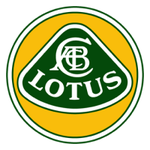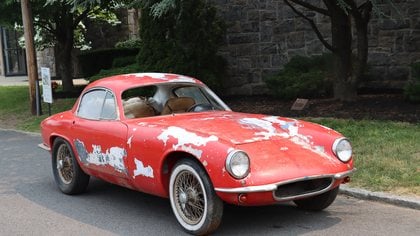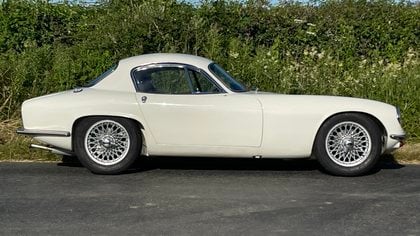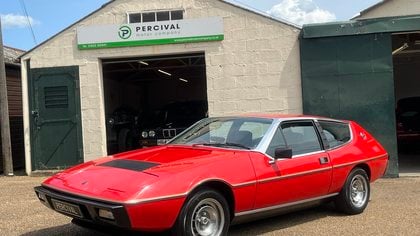Description
The first Grand Touring Lotus, the Elite represented an important step in the brand's history. It brought Lotus fame, even if the car was not financially profitable. When the prototype Lotus Elite was introduced at the Earls Court Motor Show in October 1957 it created a real stir, for not only the fact it was a pretty two-seater coupe, but because it broke new ground in many technical ways. There was no chassis by the conventional sports car ideas of the time, the car being built as a body/ chassis unit in one piece made of glass-reinforced epoxide and polyester resin “glass-fibre”. There were many problems in getting the car into production and it was over a year before the first ones began to appear.
But the Elite would go down in motoring history for its revolutionary bodywork.
A versatile car, the Lotus Elite embodied the GT philosophy: drive during the week and race at the weekend. It has been programmed according to the new regulations of the GT championship (1300 cm3 category) to aim for class victories in major international events such as the Le Mans 24 Hours.
Work on the Type 14, which was to become the Elite, began in 1956. Although very incomplete, the prototype was presented at the London Motor Show at Earls Court in October 1957.
To compensate for the modest power of the engine, Colin Chapman, a champion of weight reduction, designed an audacious self-supporting monocoque structure made entirely of plastic. A world first. The only metal reinforcements (embedded in the resin) are a protective hoop around the windscreen to which the door hinges are attached, and subframes that house the suspension and engine attachments. After initial manufacturing problems at Maximar, a firm specialising in boat hulls, production was subcontracted to Bristol.
Suspension was independent on all four wheels, there were disc brakes all round and the power unit under the bonnet was the Coventry Climax single overhead camshaft engine in a 1216 cm3 version made especially for Lotus. It was called the FWE. Built in aluminium and very expensive, it only produced 75 bhp. The BMC non-synchronized first gearbox was identical to that of the MGA. Braking was by discs on all four wheels, and the four-wheel independent suspension was borrowed from the Type 12 single-seater.
With its pure lines, clear volumes and plunging bonnet, the superb lines of the Lotus Elite are the work of Peter Kirwan-Taylor, a design enthusiast and friend of Colin Chapman. His work was reviewed by aerodynamicist Frank Costin, who was particularly responsible for the truncated stern. The result is an excellent Cx of 0. 29!
It should be noted that the Elite's windows did not slide down: they were removable and stored in a bag in the back of the seats...
September 1959 saw the launch of the Series 2, whose suspension had been modified to eliminate the steering lock caused by the flexible tie rods. The following year, Chapman launched the SE (Special Equipment) version equipped with a different camshaft and exhaust manifold. With 85 bhp obtained at 6, 500 rpm, the SE accelerated to 185 km/ h thanks to its aerodynamic qualities and light weight (640 kg), covering 0 to 100 km/ h in ten seconds. The car was also fitted with a ZF four-speed synchronized gearbox.
A Super 95 version was offered in 1962. This was a misleading name, as power was actually reduced to 80 bhp (at a lower engine speed of 6, 100 rpm). But the Elite would be offered throughout its career with more advanced engines, up to 105 bhp at 8, 000 rpm, thanks to twin Weber carburettors (instead of the single SU of the normal version) and more advanced valve timing.
Designed with competition in mind, the Elite suffers from serious shortcomings. It has to be said that Colin Chapman had no experience of building production models before launching it. It vibrated a lot and was very noisy, with the plastic bodywork acting as a sounding board. A cutting-edge car for discerning enthusiasts, the Lotus Elite also suffered from questionable reliability, not to mention tricky and expensive maintenance.
On the other hand, the Elite's roadholding was formidable, close to that of a racing car: remarkable roadholding, precise and direct steering, powerful braking. Extremely expensive to build, 1, 030 examples were produced until 1963. It was sold as a kit from 1961, which considerably reduced the price.
The Lotus Elite forged a flattering record in competition, racking up numerous class victories. Its sober engine also enabled it to win the energy index twice at the 24 Hours of Le Mans (in 1960 and 1962). Average fuel consumption was just over 15 litres per 100 kilometres, with a top speed in excess of 220 km/ h!
DAD 10
At the Brands Hatch race meeting on Boxing Day 1958 there were five production Lotus Elites entered for the Production Sports and Grand Touring Cars event and a memorable battle took place between Colin Chapman in a works car and Jimmy Clark in the Border Reivers car, with a narrow victory going to the founder of Lotus Cars. In third place in another Lotus Elite was Mike Costin, the Cos of Cosworth Engineering and key man on the production of the Cosworth DFV in later years. That Brands Hatch race was indeed significant in the history of British motor racing. By mid-1959 the Lotus firm had moved from Hornsey in North London to Cheshunt in Hertfordshire and production of the Lotus Elite really got under way, with the bodyshell being made by Bristol Aeroplane Plastics Ltd.
When Doug Nye wrote bis book “The Story of Lotus 1961-1971” Colin Chapman told him “The Elite was really a road-going car and used many of the racing components. We didn’t have much experience of road-car economics when we designed it, and without long-range tooling, long-range buying and strict cost-saving it was finally just uneconomic to build. I believe we lost over £100 on each car we built.” Nonetheless they built 285 of the Series I cars and by October 1960 the Series II was introduced, which had revised rear suspension, and 703 of these were built in the ensuing years, making a total of 988 altogether. When Colin Chapman described the Elite as a road-
going racing car, he was not far wrong for once production was under way they were raced in every type of event from Mallory Park club meetings to the Le Mans 24 Hour race and Nurburgring 1, 000 kilometers races and were highly successful in the small GT category. Many of them became famous and many of them were registered with special number plates, like CB 23 for Chris Barbour, the jazz-man, WUU 2 for Peter Lumsden and LOV 1 for Graham Warner, but the one being featured in this series is DAD 10, not because it is the most famous, and the most successful but because it was symptomatic of the “swinging-sixties”. This Lotus Elite was owned by Les Leston who was running a very successful motoring accessory business in London and he was also into the London jazz and rock music scene. In the early Swing days the name “Daddy” was given to old men with money to burn on living it up with wine, women and song and any young girl who picked up a rich “Daddy” was known to have a “Sugar Daddy”. When Rock took over from Swing the principles were unchanged and “Daddy” was changed into “Dadio”. Leston’s racing Elite was registered DAD 10, which easily changed itself into DADIO and the car soon became called “Dadio”. All of which fitted neatly into the life and business style of Les Leston Accessories.
Apart from all that “Dadio” was a very quick car and Leston was one of the club “aces” of the time, racing it extensively in the early sixties and having some memorable battles with Graham Warner in LOV 1. Leston’s best effort with the red Elite with the white stripes was to finish 7th overall in the RAC Tourist Trophy race at Goodwood in 1961, only six laps behind the winning Ferrari. Its 1, 220 c. c. Coventry-Climax engine used two twin-choke Weber carburetters, which developed 105 b. h. p. and drove through a ZF gearbox to a 4. 87 to 1 differential unit. The car weighed 9 3/ 4 cwt. and accelerated from 0-100 m. p. h. in 17. 6 sec. and at Goodwood it clocked 128 m. p. h. on the Lavant Straight.
After Les Leston stopped racing it, the car passed through two new owners’ hands but they did not race it, and then it disappeared into the murk of the second-hand car-dealer world and was lost about 1966.
Our Mos 10 is a well-preserved 1962 Lotus Elite Series II, which was purchased by Neil Twyman through Charles Fripp in 2009. After a thorough diagnosis of its originality, Twyman decided to rebuild it as a tribute to the former Les Leston DAD 10 with its specific Franck Costin front end. The renowned Neil Twyman put all his effort and knowledge into building a highly accurate and competitive replica of the famous period car. The best English craftsmen supplied the various components: Crosthwaite & Gardiner, MK14, Climax Engine Services, Tony Thompson, Bodicraft Supplies and Panel craft ltd. Nothing has been left to chance, as you'll see.
The MOS 10 boasts Leston's distinctive front grille, among other period factory features. After spending some time in the hands of Twyman, it finally joined the JD Classics stable. The car once again received an extensive preparation and raced successfully in the JD Classics colors. At the 2016 edition of Le Mans Classic, it proved to be the fastest Elite in Plateau 3, winning 1st place in the performance index. Subsequently, the current owner purchased the MOS 10 from JD Classics and raced the car entrusted to the ATS workshop in Le Mans. The owner maintained the car to a very high standard and also purchased a large number of spare parts to accompany the sporting career of his Lotus: 1 ZF gearbox overhauled by Marel & Pellin, 1 complete FWE engine overhauled, 1 spare dif carburetors, front brake calipers, doors, hoods, wheels....
Ready to race, and sold with its own set of spare parts, this Lotus Elite is probably the sports car offering the greatest eligibility in the great historic races: Tour Auto, Goodwood Revival, Le Mans Classic, Fifties' Legends.....
















